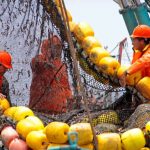The authority has announced that the commercial harvesters are being barred from landing Atlantic herring in the western half of the Gulf of Maine during certain periods this month, a move aimed at averting an early closure of the area. Patrice McCarron, executive director of the Maine Lobstermen’s Association, told that herring boats provide most of the bait for Maine lobstermen.
She also told that it’s going to be tight for September, the backbone of bait for the lobster industry is herring. It is true that lobstermen have access to other sources of bait, such as pogies and redfish, she said, but supplies of those species are too small to make up for a lack of available herring. McCarron also said that the situation could have been worse. Herring fishermen in Massachusetts and New Hampshire prefer larger midwater trawlers to the smaller purse-seine boats that Maine fishermen use to catch fish at or near the surface.
According to federal rules trawlers bar from fishing in the inner Gulf of Maine before Oct. 1, and fishermen in the other two states were worried that Maine fishermen might meet the annual quota before they could even deploy their nets. The catch limit set by federal regulators was reduced in 2007 from 60,000 metric tons to 55,000 metric tons. Terry Stockwell, director of external affairs for the Maine Department of Marine Resources, expressed that until recently, it’s thought that the lobster industry by itself has been using about 60,000 metric tons of herring a year.
He added that in the past year, however, lobstermen have adjusted their practices to use less bait and last year were able to supplement their supply by importing herring caught in Canadian weirs. The Atlantic States Marine Fisheries Commission’s Herring Section members from Maine, New Hampshire and Massachusetts will meet on Sept. 24 to determine if additional days out of the fishery will be needed to extend the quota into October and November.








